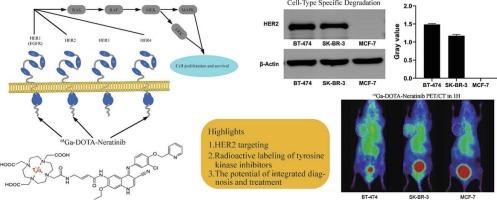68Ga-DOTA-Neratinib:一种用于乳腺癌成像的新型小分子PET示踪剂。
IF 4.7
2区 医学
Q1 BIOCHEMISTRY & MOLECULAR BIOLOGY
引用次数: 0
摘要
目前基于dota的68ga标记的靶向HER2的小分子探针通常具有有限的肿瘤特异性摄取。为了克服这一局限性,我们选择了第二代泛her酪氨酸激酶抑制剂Neratinib,并成功开发了一种新型PET显像剂68Ga-DOTA-Neratinib。该探针具有较高的放射化学产率、良好的体外和体内稳定性以及对HER2受体的强结合亲和力。细胞摄取实验证实了her2阳性细胞系的特异性积累:孵育后2小时,BT-474和SK-BR-3细胞的摄取分别为7.55±1.10%和8.18±0.56%,显著高于her2阴性MCF-7细胞(4.71±0.79%),p68ga - dota - neratinib是一种有前途的小分子PET探针,用于her2阳性乳腺癌的无创成像。本文章由计算机程序翻译,如有差异,请以英文原文为准。

68Ga-DOTA-Neratinib: A novel small-molecule PET tracer for breast cancer imaging
Current DOTA-based 68Ga-labeled small-molecule probes targeting HER2 often suffer from limited tumor-specific uptake. To overcome this limitation, we selected Neratinib, a second-generation pan-HER tyrosine kinase inhibitor, and successfully developed a novel PET imaging agent, 68Ga-DOTA-Neratinib. The probe demonstrated high radiochemical yield, excellent in vitro and in vivo stability, and strong binding affinity for the HER2 receptor. Cell uptake assays confirmed specific accumulation in HER2-positive cell lines: uptake in BT-474 and SK-BR-3 cells at 2 h post-incubation was 7.55 ± 1.10 % and 8.18 ± 0.56 %, respectively, significantly higher than that in HER2-negative MCF-7 cells (4.71 ± 0.79 %, P < 0.05). Moreover, micro-PET/CT imaging in HER2-positive tumor-bearing mice showed enhanced tumor uptake and prolonged intratumoral retention of the tracer, though some background blood activity was also observed. These findings suggest that 68Ga-DOTA-Neratinib is a promising small-molecule PET probe for the noninvasive imaging of HER2-positive breast cancer.
求助全文
通过发布文献求助,成功后即可免费获取论文全文。
去求助
来源期刊

Bioorganic Chemistry
生物-生化与分子生物学
CiteScore
9.70
自引率
3.90%
发文量
679
审稿时长
31 days
期刊介绍:
Bioorganic Chemistry publishes research that addresses biological questions at the molecular level, using organic chemistry and principles of physical organic chemistry. The scope of the journal covers a range of topics at the organic chemistry-biology interface, including: enzyme catalysis, biotransformation and enzyme inhibition; nucleic acids chemistry; medicinal chemistry; natural product chemistry, natural product synthesis and natural product biosynthesis; antimicrobial agents; lipid and peptide chemistry; biophysical chemistry; biological probes; bio-orthogonal chemistry and biomimetic chemistry.
For manuscripts dealing with synthetic bioactive compounds, the Journal requires that the molecular target of the compounds described must be known, and must be demonstrated experimentally in the manuscript. For studies involving natural products, if the molecular target is unknown, some data beyond simple cell-based toxicity studies to provide insight into the mechanism of action is required. Studies supported by molecular docking are welcome, but must be supported by experimental data. The Journal does not consider manuscripts that are purely theoretical or computational in nature.
The Journal publishes regular articles, short communications and reviews. Reviews are normally invited by Editors or Editorial Board members. Authors of unsolicited reviews should first contact an Editor or Editorial Board member to determine whether the proposed article is within the scope of the Journal.
 求助内容:
求助内容: 应助结果提醒方式:
应助结果提醒方式:


